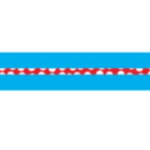Paper, Autonomous Self-Healing Structural Composites with Bio-Inspired Design
Strong and tough natural composites such as bone, silk or nacre are often built from stiff blocks bound together using thin interfacial soft layers that can also provide sacrificial bonds for self-repair. Here we show that it is possible to exploit this design in order to create self-healing structural composites by using thin supramolecular polymer interfaces between ceramic blocks. We have built model brick-and-mortar structures with ceramic contents above 95 vol% that exhibit strengths of the order of MPa (three orders of magnitude higher than the interfacial polymer) and fracture energies that are two orders of magnitude higher than those of the glass bricks. More importantly, these properties can be fully recovered after fracture without using external stimuli or delivering healing agents. This approach demonstrates a very promising route towards the design of strong, ideal self-healing materials able to self-repair repeatedly without degradation or external stimuli.
Learn about our two Decals!
 Click here to find out more about our Fall Bioinspired Design Decal and our Spring Bioinspired Design in Action Decal – ALL MAJORS are welcome.
Click here to find out more about our Fall Bioinspired Design Decal and our Spring Bioinspired Design in Action Decal – ALL MAJORS are welcome.Berkeley BioDesign Community
 Click here to learn about the BioD: Bio-Inspired Design @ Berkeley student organization or here to signup for more info.
Click here to learn about the BioD: Bio-Inspired Design @ Berkeley student organization or here to signup for more info.Search
Student Login






I imagine that the neurological circuits underlying these processes are governed by both 2d spacing maps with their brains as…
to reduce the impact of car accidents, it may be possible to study the force diverting physics of cockroaches to…
you see this type of head-bobbing stability in many avian creatures related to pigeons like chickens. the head ability to…
not like they taught horses how to run! this is an example of convergent evolution where both sea creatures and…
The brain functions in a similar way with neuronal connections. our brains are able to utilize the multiplicity of connections…